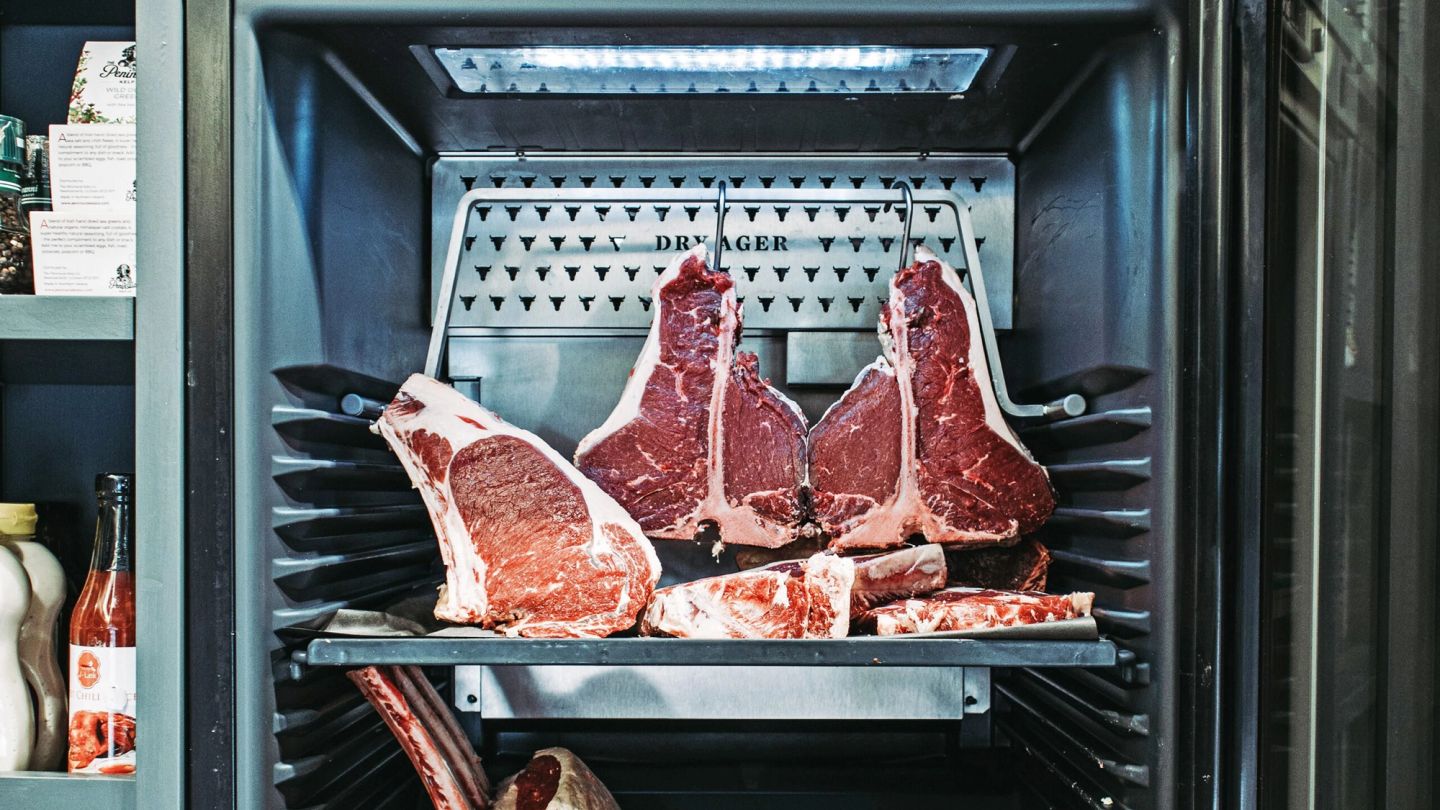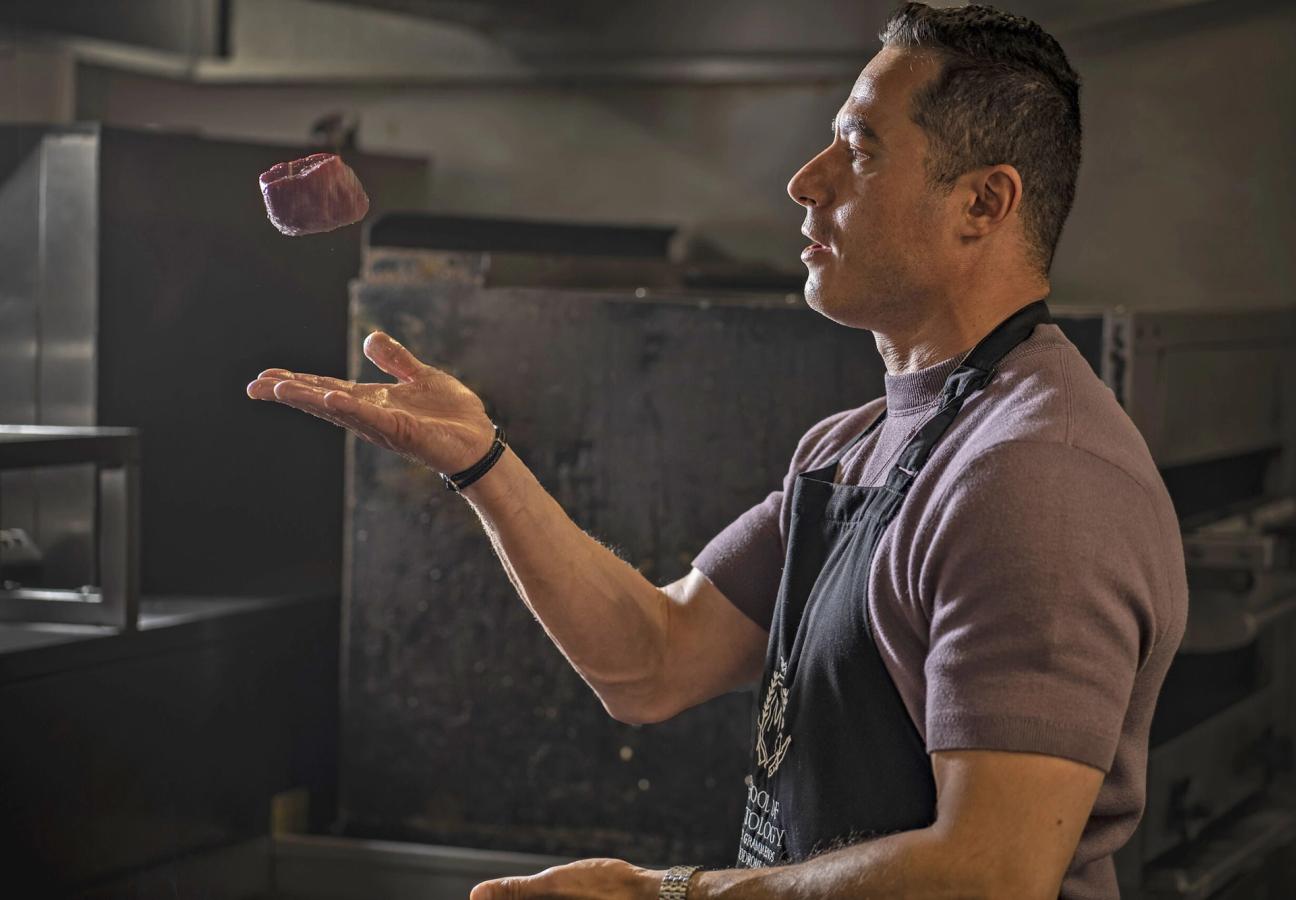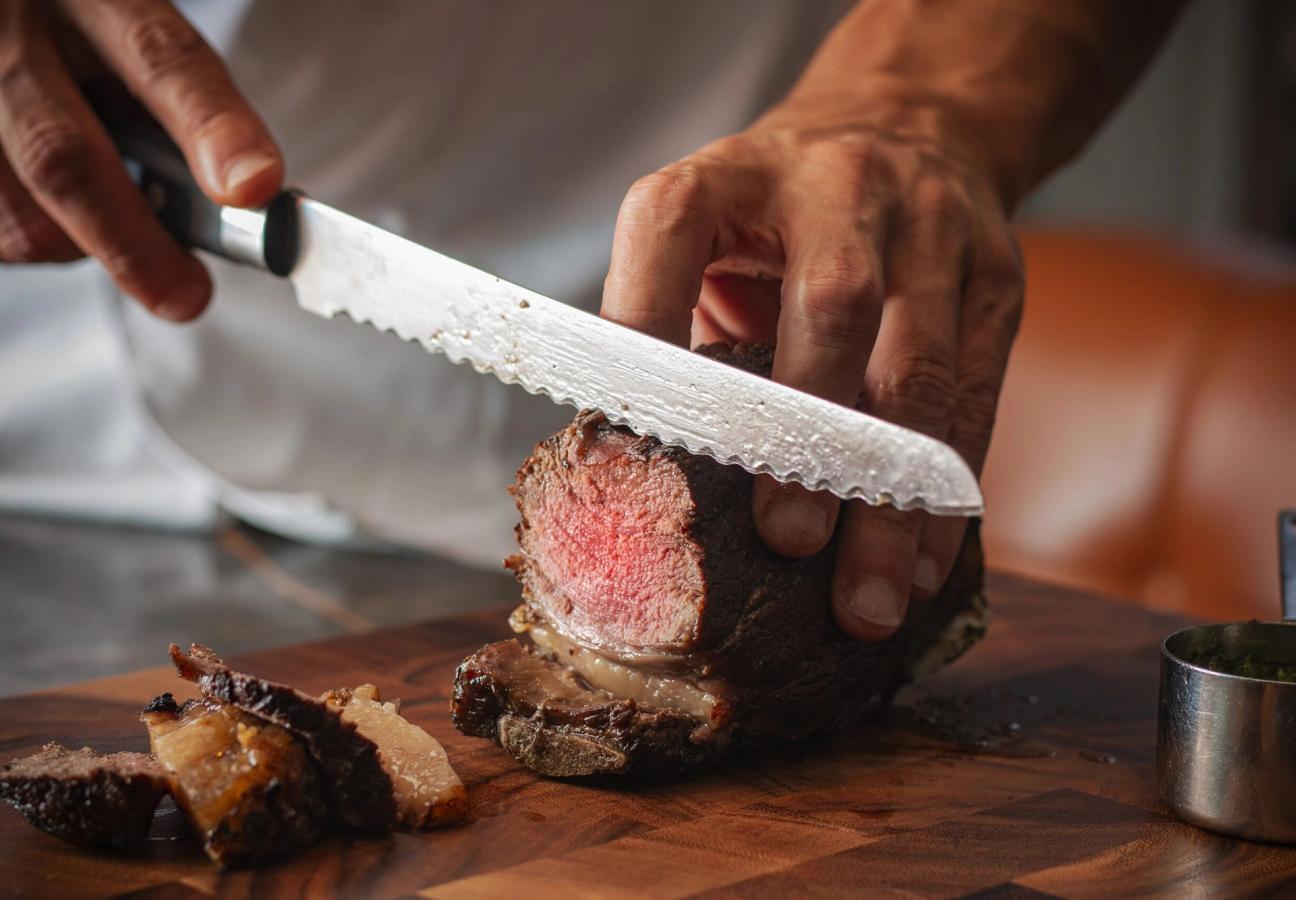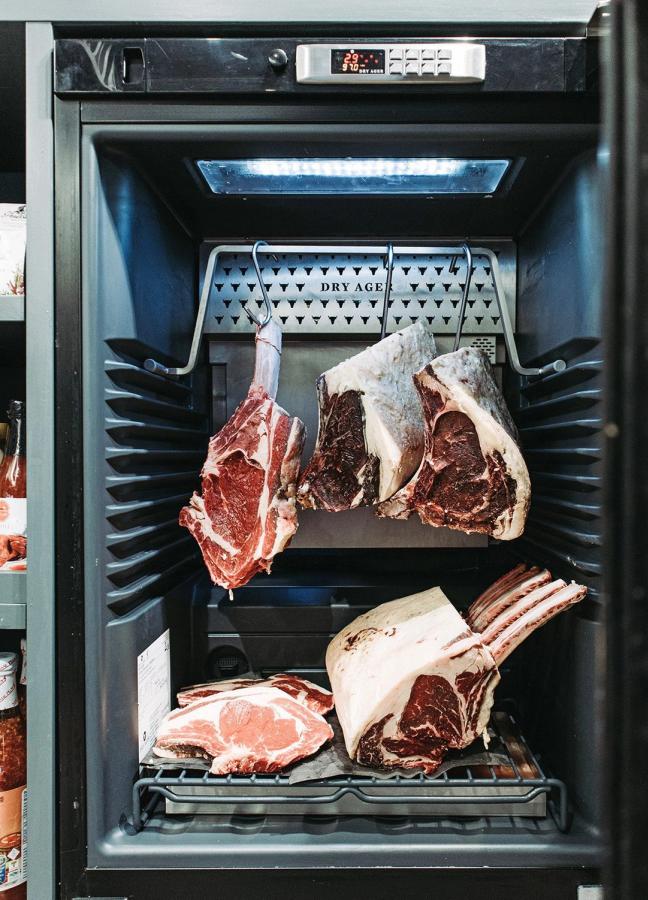

Inside the rarefied world of extreme-aged steak
From salt slabs and UV light baths to the art of ‘controlled decomposition’, we carve into one of the most luxurious, lip-smacking corners of high-end cuisine…
Words: Jonathan Wells
Ioannis Grammenos can remember the precise moment his heart was broken. Like so many of us, lockdown had left the chef bereft; his West End haunt, the Heliot Steak House, had been shuttered — and he had no team left to train, no guests left to serve and no dishes left to devise. And yet, all was not lost. For, in one of the restaurant’s state-of-the-art steel fridges, the most piquant project of his career was coming along nicely.
Hanging by a hook, an exemplary cut of exceptional beef had become Grammenos’ chef-dœuvre; his meaty masterpiece. The steak specialist had been nurturing it for months before lockdown hit, nudging it gently but confidently towards a record-breaking age. His kitchen staff would jokingly refer to it as ‘The Mummy’, and it was already over two years old when the steakhouse was forced to close. Grammenos had taken to clandestine visits, dropping in once every four days to maintain the kitchen and attend to this unique cut. But, on one such visit — 670 long days into the ageing process — the power was out.
“The fuse blew,” Grammenos grimaces. “And, when I came in, the fridge had already been off for four days. That steak, which I had been ageing for over two years, had been sitting there, at a temperature of 24 degrees, defrosting. So we lost it. It was destroyed”.
Heart; broken. Meat; ruined. Welcome to the rarefied, ruthless world of extreme-aged steak.
It’s a world of bizarre practices, big characters — and even bigger flavours. Across the world, chefs and beef buffs are constantly innovating; inventing new ways to extend the life of these prime, precisely-chosen cuts. They’re cross-breeding cattle, firing up dazzling antimicrobial LEDs and shlepping salt blocks back from the slopes of the Himalayas to line their ageing fridges.
And such fridges! Vast, glowing and dedicated to “controlled decomposition” (a phrased coined in 2013 by New York butcher George Faison), they’re like grand mausoleums of meat; dry-ageing great slabs of steak by carefully tweaking temperature and humidity. Grammenos introduces me to his twins — a pair of nine-year-old fridges sitting proudly in the kitchen of the steakhouse.
“They can hold 100 kilos of meat each,” he says. “But I don’t put more than 85 kilos in each, because I want the fridges to breathe. I don’t want to push them to the limit. To age the meat, what you need to do is to create a ‘cocoon’. That’s the idea. The cuts age from the outside in — so the outsides will get quite dark in colour, and hard. Inside, the steaks will turn a very deep, dark red. It’s like a butterfly’s cocoon; it takes time”.
"What you need to do is to create a ‘cocoon’…”
By controlling the climate of the fridge — something Grammenos’ team monitors three times a day, documenting in a closely-guarded book — the chef can decide for how long he is going to age each cut. Lower temperatures and humidity mean he can age a steak for longer. Higher temperatures, and humidity up to 80%, will let you age the meat for around three weeks.
And this is what most steakhouses will do. Elsewhere in London, The Ginger Pig and Hawksmoor both age their oldest steaks to 35 days (the oldest on the Heliot Steak House’s everyday menu is 40-day aged). Blacklock, the much-championed chophouse that opened in Soho in 2015, will dry-age steaks for up to 55 days. And, across the North Sea, the Danish beef served at the MASH steakhouse chain may have spent up to 90 days developing its flavour.

Ioannis Grammenos
So is it safe? With phrases like Faison’s queasy “controlled decomposition” being bandied around the butcheries, these long-life steaks have been known to cause concern. But Grammenos assures me that every precaution is taken — even with the youngest of the ‘aged’ cuts. When a piece of meat has spent 40 days in his prized fridges, an independent lab is invited into the kitchen to take 100g samples from each cut and test these for harmful bacteria. In eight years, they’ve never had a problem — and Grammenos puts that down to his meticulous research-based methods.
“It’s pure science,” he shrugs. “With this process, you prevent any bacteria from growing on the meat. Food usually spoils from the outside, where mould or pathogenic bacteria develops. But I keep my fridges at one degree. So it’s cold, and the humidity is 78% — just enough so it doesn’t stress the meat. Because it’s like wine; you need to treat it right and give it time to change flavour”.
There’s also a fan, the chef points out, mounted to the inside of each of his fridges. Around the same size and shape as a house brick, these add-ons cost more than the fridges themselves. They draw in the meaty air, fiercely cleanse it of pathogenic bacteria with a shock of UV lights, and return it back into the fridge. And, sitting below the beef, two-inch flagstones of bright pink salt absorb excess moisture — and put the ‘dry’ in ‘dry-age’.
“And then,” Grammenos continues, now in full health-and-safety swing, “we trim the meat. We remove all of the dead tissue from the cuts. And we do that using a bandsaw. Like the lab, a company comes in from outside with a bandsaw, we bolt it to a table and we cut the steaks”.
And these steaks, explains Grammenos, need to come from choice cuts of meat. Around the world, different specialist chefs have their own ideas about the best cuts for dry-ageing. In New York City, Italian restaurant Osteria Morini often offers a special of rib-eye, aged to 125 days. Across town, Eleven Madison Park one-ups them by fifteen days; offering the same cut of meat after 140 days of dry-ageing. But Grammenos disagrees.
“I’d go for a tomahawk, or a ’T-Bone’,” he says. “And I’m ageing both of those cuts now, and will get them to the age of ‘The Mummy’. Because, for a steak to age well, it needs to have a lot of marbling — and a bone.
“That’s if you want to age it for a long time,” he adds. “If you want to age for a shorter period — one or two weeks — then it doesn’t have to be on the bone. But for longer ageing, on the bone. And that’s because there’s nothing to hold the muscle stretched out if there’s no bone. That way, it’ll shrink, shrink, shrink and become tough. The bone keeps it firm — but soft”.
The chef has many, many more stipulations for his steak. Every piece of meat must be humane-certified and GMO-free — whether it’s sourced from Argentina or Arkansas. Or, indeed, from Finland — which Grammenos offers up as the destination to watch for quality cuts. “It’s weird,” he nods, “but they’re winning every year in the blind tastings”.

Speaking of, let’s proceed to the palate. If your brow furrows and your eyebrows raise at the thought of extreme-aged steak, why not let your tastebuds have a try? Because these soft, seasoned steaks can offer up a controlled cacophony of incredible flavours if aged correctly. Depending on the day you pluck them from their fridges, dry-aged steaks can sing with notes of rich truffle, tangy blue cheese or satisfying umami. And your individual flavour preference, Grammenos reveals, will dictate the age of the steak you should choose.
“The meat changes flavour every 15 to 20 days in the ageing fridge,” the chef says. “After 20 days, it’ll have a nice, intense flavour. Then, after 40 days, it’ll start to have notes of stilton and blue cheese. After that, some notes of walnut, also.
“The meat changes flavour every 15 to 20 days…”
“And, by 60 days, the blue cheese flavours are really strong. Then, at 120 days, you’ll start to taste some gamey flavours. Heavy, heavy flavours by then. At 150 days, there’s such a strong flavour of blue cheese. Stilton, sure — but also all the other heavy cheeses, everything together.
“After that,” he continues, “a strange thing happens. For the ten days between 150 and 160 days, it’s not so strong. The flavour softens and comes down for those ten days. But then it goes off again, getting more flavourful up to 200 days — and then it stays much the same after that”.

It’s an incredible trajectory of taste — and one that unsurprisingly comes at a cost. Like any luxury in life, extreme-aged steak doesn’t come cheap. That 620-day-aged steak Grammenos lost during lockdown? The plan was to let it mummify its way to 700 days, before selling it at the Heliot Steak House as a special. A 220g serving — “300g with the bone,” offers the chef — would have been yours for £900.
“There are many reasons they cost this much,” explains Grammenos. “You’ve got a fridge working 24/7 for many months. You’ve got specialists who must be brought in to trim off the outside. And all of this means that the price goes up. But the main reason they get more expensive is because they lose weight. When you put meat into the fridge and start ageing steak, it shrinks. You’ll lose almost 30% of the original weight”.
And Grammenos maintains that, had his 700-day-aged steak made it to the menu as a special, it would have been just that — a once-in-a-lifetime cut for only the most committed of carnivores. “Although,” he laughs, “we do have a guest here who comes in four times a week, and he has a 40-day aged steak every time”.
But such customers are rare, says the chef. (Incidentally, you should never mention the ‘R’ word in front of Grammenos. He always advises customers to order their aged steaks medium rare, if not medium, to fully extricate the flavour). And those who commonly order extreme-aged steak are even rarer. Out in Los Angeles, one of the least-ordered dishes at Adam Perry Lang’s APL Steakhouse is a bone-in New York strip steak that’s been dry-aged for 380 days. It costs $150, and Lang says it tastes like the meaty equivalent of “turning a grape into a raisin”.
Grammenos agrees. “It’s a special meat,” he nods. “A special flavour. But you don’t eat this every day, because it’s not a regular steak. It’s expensive, yes. But, if the steaks are something that you love, then it’s worth it”.
Want more fine kitchen kit? Win a Gozney Pizza Oven worth £1,499…
Become a Gentleman’s Journal member. Find out more here.


